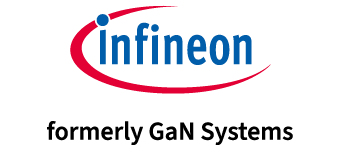网络研讨会:基于氮化镓的 3kW AC/DC PSU 的益处和优势
请跟我们一起来探讨基于氮化镓的 3kW 无桥图腾柱 (BTP) PFC+LLC 的设计和性能。 我们将重点介绍氮化镓晶体管与硅或碳化硅 MOSFET 相比的优势,用于 BTP PFC 和 LLC 转换器以及高频设计考虑因素,例如磁变压器和 PCB 布局。 实验结果表明氮化镓的卓越性能超过 80+ 钛要求,并且高功率密度大于 80W/in3.
在本次网络研讨会中,您将了解到:
- GaN 晶体管在 3kW AC/DC PSU 中的优势
- 如何超越高密度数据中心 PSU 的 80+ 钛要求
- 高频磁性和 PCB 布局的系统设计注意事项
问答
What is the maximum input voltage of the Full Bridge LLC?
The maximum voltage of the LLC input is 420V DC. The LLC input voltage range is from 380V to 420V.
What is the package of your GaN used in the reference design?
The GaN transistor package is 8×8 PDFN package with part number GS-065-030-2-L, 650V 50mΩ.
Could we get the detail test report for the 3KW PSU design?
Yes, we have two EVB for this 3kW PSU. One is the 3kW bridgeless totem pole PFC and the other is the 3kW Full bridge LLC. There are technical manuals for these two reference designs on our website. You may also order the EVB from GaN Systems through our sales channels.
Could you talk about EMI design to PFC topology? Why does bridge diode Boost PFC has better EMI performance?
For the PFC stage, the key noise difference is the common mode noise. For bridge diode Boost PFC, the bridge diode rectifies the AC voltage to DC voltage before the Boost circuit, so there is no severe common mode noise. However, for totem pole PFC either CCM or CrM, there is a common mode noise current occurring around the input voltage zero-crossing brings severe EMI problem restricts its practical application. There are methods to solve the common mode noise for totem pole PFC: such as right Y-cap location and additional diode on the switching branch. There are many technical papers discussing how to suppress the common mode noise. For differential mode noise, high switching frequency minimizes the DM noise for the PFC, which is another advantage of high frequency GaN. Also, GaN’s no reverse recovery characterisitc reduces the high di/dt noise on the switching node, which also helps minimize EMI. Refer to our paper in Bodo magazine for more information on high frequency PFC with low DM noise.
Titanium+ has different meanings to different customers. What is a practical efficiency target higher than 96% for the PSU? Is it 97%, 97.5%, other?
We have seen some datacenter customers requiring higher efficiency levels than Titanium, we called it Titanium+. But there is no clear answer on how much efficiency higher than Titanium. Requirements up to 97.5% at peak efficiency are becoming common. Additionally, 10% and 20% light load efficiency requirements are increasing also by 1-2% higher than the Titanium requirements. GaN transistor play an important role in achieving these requirements.
For the PFC, how is GaN better than SIC?
There are several items:
- As mentioned in the webinar, both GaN and SiC can be used for CCM bridgeless totem pole PFC. However, the SiC MOSFET has an intrinsic body diode with reverse recovery charge, Qrr, causing high switching loss which significantly impacts the efficiency at half load to full load when temperature rise. With switching frequency above 100KHz, efficiency is 0.5% higher with GaN.
- GaN works very well in super high frequency advanced CrM totem pole PFC with MHz switching, while the SiC MOSFET has significant limitations in this type of application due to SiC high gate drive and turn-off losses.
Are you planning to characterize this topology for bidirectional power delivery?
GaN transistors have many benefits for DAB (Dual Active Bridge) and CLLC resonant topologies for bi-directional DC to DC operation. The value is low switching losses, low gate drive loss and zero Qrr for GaN, thus high frequency with high power density. GaN Systems has a simualtion tool to characterize GaN’s benefits for the bi-directional DAB topology (https://gansystems.com/design-center/dual-active-bridge/). Also, an IEEE paper ” System Design of Dual Active Bridge (DAB) Converter Based on GaN HEMT Device” in 2019 22nd International Conference on Electrical Machines and Systems (ICEMS) clearly demostrates GaN’s value for the DAB topology with high efficiency and high power density. (https://ieeexplore.ieee.org/document/8921597)
Can the GaN transistors in Full Bridge LLC support a higher input voltage? For example, using the LLC as a stand alone DC/DC converter for traction voltage to 48 V in an EV.
The LLC topology has a limited input and output range due to the variable switching frequency mode for the LLC. GaN transistors have low switching turn-off loss and dead time reverse conduction loss which helps the LLC topology operate with a wider input and output range with wider frequency range. However, if it is 48V to 400V input, it is very difficult for the conventional LLC, which is limited by the topologies’ property of the LLC, not GaN transistors. If 48V to 400V voltage range is nessesary, phase shift full bridge (PSFB) topology with ZVS can be considered. An example for PSFB with GaN is as the following paper title: “Power Density Optimization of 700 kHz GaN-Based Auxiliary Power Module for Electric Vehicles”. (https://ieeexplore.ieee.org/document/9205605).
Do you have any recommendations for thermal management?
Yes, thermal management is very critical for high power density design. We have a specific webinar on this topic. Visit our website to view the webinar, the title is “Thermal Management Guidelines for GaN Transistors”.
Do you have any recommendations for thermal management?
Yes, thermal management is very critical for high power density design. We have a specific webinar on this topic. Visit our website to view the webinar, the title is “Thermal Management Guidelines for GaN Transistors”.
Is the reported efficiency including the fan power?
The fan power is not included in the efficiency data as usual, but auxiliary power is included in the efficiency data.
Do you have any ideas that could improve the LLC resonant converter as the major losses are on the rectifiers and the transformer?
For LLC transformer, the core selection, winding design, distributed air-gap, and winding structure are discussed in our webinar. All of these considerations are proposed to reduce the transformer loss. For example, the distributed air-gap can minimize the fringing effects and reduce the leakage flux coupling losses on the winding, which is a very practical method for a high frequency LLC. For synchronous rectification, the dominate losses are conduction loss which is relative to the Rdson of the transistor. For our 3KW LLC design, we use 150V 4.4mΩ SR MOSFET with 2pcs in parallel for low BOM cost. In order to further reduce the SR total loss, implementing more MOSFETs in parallel will reduce conduction loss. Meanwhile, thermal design can be optimized for high efficiency with a copper slug or heatsink on the back of the SR MOSFETs to reduce the temperature.
On an AC to DC converter using a tapped transformer, is it possible to use only GaN to do the AC to DC rectification?
GaN can definitely be used for LLC as a synchronous rectification (SR) transistor with lower switching loss and gate drive loss. However, for this GaN based 3KW full bridge LLC design, the output voltage is 54V with center-tapped full wave rectification, so the breakdown voltage of the SR transistor needs to be 54Vx2=108V. This results in a breakdown voltage of the SR transistor around 150V. Currently, GaN Systems does not have GaN transistor products with 150V breakdown so, in this 3KW LLC design, we chose 150V 4.4mΩ Si MOSFET with 2pcs in parallel per switch.
Did you consider a planar transformer for the LLC converter?
In the 3KW LLC reference design, we used a PQ4030 core which has a low profile, less than 30mm. 0.2mm*7.5mm flat copper is used for high frequency, high current. Compared to a planar transformer, it is easier for transformer vendor’s to manufacture.
Can the switching frequency of the 3kW bridgeless PFC go above 65kHz, such as 200kHz? Is there any limit?
Yes, GaN can go higher frequency than 65KHz for bridgeless PFC. As we seen, the 3KW bridgeless totem pole PFC has high efficiency and low temperature, meaning it can operate at switching frequencies higher than 65KHz. We have designs at higher frequencies we can share with customers as they become more comfortable with high frequencies.
The LLC converter operates at 250KHz resonant frequency. Can it be higher?
Yes, GaN devices can operate at high frequency, 1MHz, for soft switching frequency. We do have customers using our GaN with frequency higher than 500KHz for soft switching. In this 3kW LLC reference design, we accomodated the passive components, such as transformer and inductor, using conventional PQ core design. If it is higher frequency such as 500KHz, more advanced core material or core structure such as matrix transformer is used.
How can soft switching improve efficiency of totem pole boost?
For conventional CCM totem pole PFC, we prefer hard switching, not soft switching. With GaN’s zero Qrr and low switching loss, the CCM totem pole PFC can achieve very high efficiency near 99%. So for high power PFC, it is not necessary to implement soft switching totem pole PFC. Meanwhile, if super high density is needed, soft switching totem pole, such as ZVT or CrM can also be considered with GaN. In this case, the operating frequency can be above 500KHz. The GaN benefits for soft switching totem pole PFC is low gate drive loss and low turn-off loss. The trade-off is that soft-switching ZVT or CrM is more complicated and additional components compared to conventional CCM totem pole PFC.
The webinar identifies Co(tr) as a key parameter for the LLC topology. How much advantage is there with GaN vs Si or SiC MOS?
As we discussed in the presentation, Co(tr) matters for high frequency LLC performance. The Co(tr) is calculated as the output charge, Qoss, divided by the voltage. At 400V operation, Si SJMOS has ~10x higher Co(tr) than GaN; SiC MOS has ~50% higher Co(tr) than GaN for the same Rdson 650V transistor.
Which controllers are used for the totem pole PFC and the LLC converter?
For the totem pole PFC, it is a TI UCD3138 controller. For the LLC, it is an ST STM32F334C8 MCU controller.
Moderator: Paul Wiener
VP Strategic Marketing at GaN Systems
Paul Wiener is GaN Systems’ Vice President of Strategic Marketing. Prior to joining GaN Systems, Paul led the power magnetics business unit at Eaton. Paul brings more than 25 years’ experience in operations, sales and marketing, and business development. His experience includes vice president of sales at Fultec Semiconductor Inc. and several management roles at Genoa, BroadLogic, and Raychem.


